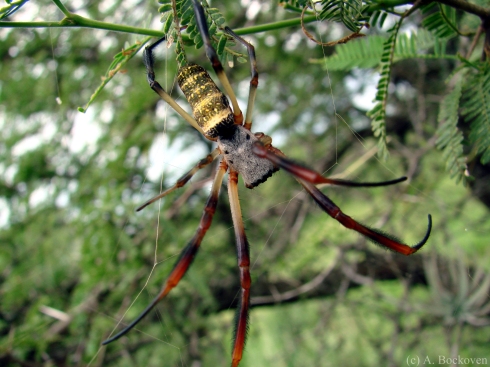
Sexually dimorphic garden spiders oppose each other on a web (Araneidae: Argiope). (Photo by Jessica Hyde)
For Valentine’s Day we have garden spiders. These are the big spiders you find with the zig-zag patterns in their webs. It turns out their mating habits are even more entertaining than I had thought (journal articles are fun!).
The much smaller males build mini-webs in at the edges of the females’ webs, often complete with their own tiny zig-zag. Then the male commences a careful and prolonged courtship, plucking and vibrating the strands of the female’s web to play her a love song. He’s trying desperately to convince her to mate with him before she decides to eat him. In this case, his small size is an advantage. His lady love may ignore him because he’s of little nutritional value.
Like other spiders, the male uses his pedipalps to transfer sperm. This is the part where a previously quiescent female may turn vicious–a quarter of males are killed during the first insertion attempt. The little male is hoping to manage one insertion with each pedipalp, as surviving through two insertions uneaten will increase the number of eggs he fertilizes.
After that, his lover’s appetite will become a moot point: during the second insertion the male will spontaneously suffer a fatal seizure. Although this could be interpreted as a romantic sacrificial gesture (box of chocolates, anyone?) it is more likely he is using his body as a plug, to try to block the access of other males.
Be mine, Valentine?
—-
Thanks to Jessica, who took the picture for me after I ran around the ranch house squeaking about dimorphism and catching grasshoppers to toss to the spiders. Thanks also to the spiders, who caught me a gorgeous buprestid specimen which I stole and unwrapped.
(Elgar 1991; Foellmer 2004; Hickey & Lee 2004)




Recent Comments